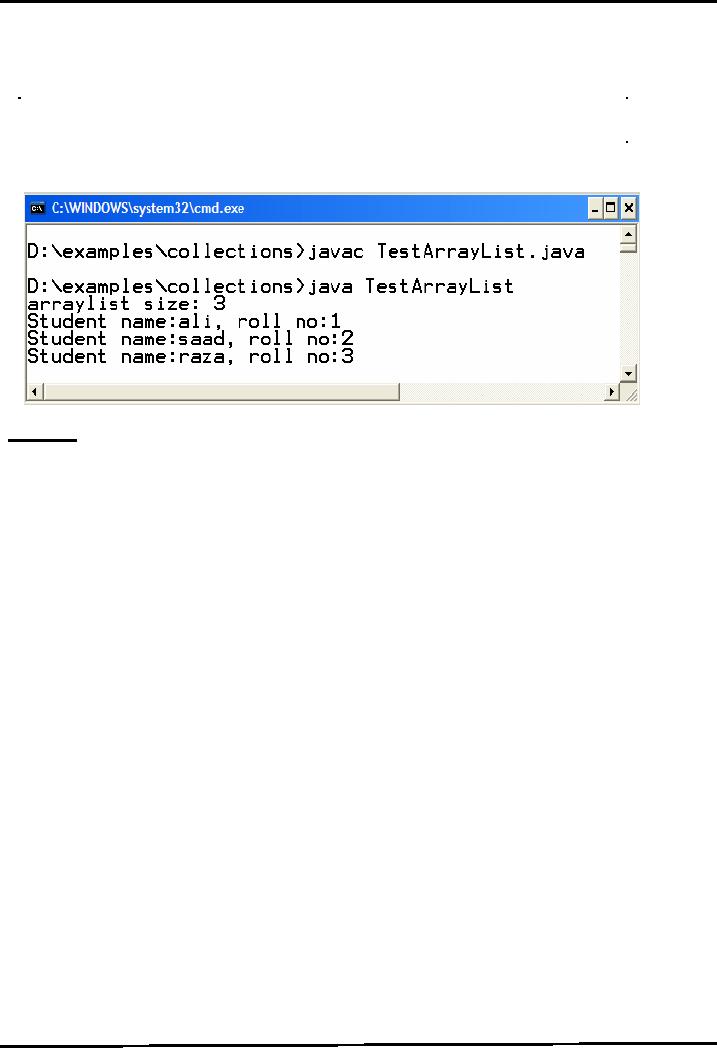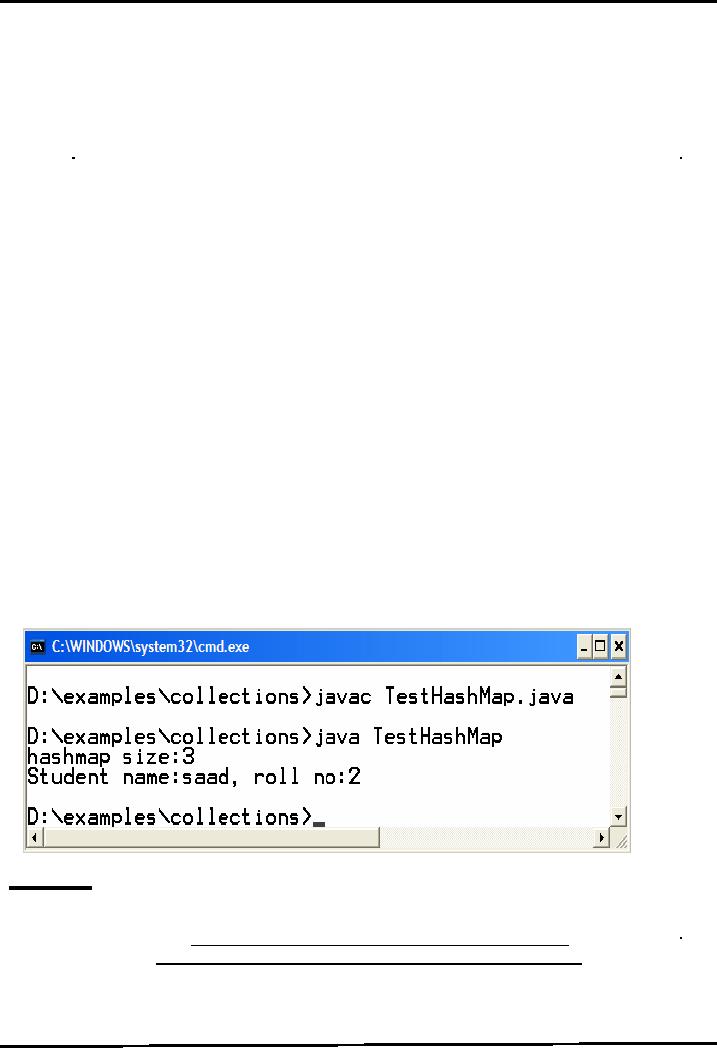 |
JAVA: Collections |
| << JAVA: Inheritance |
| JAVA: Intro to Exceptions >> |

Web
Design & Development CS506
VU
Lesson
6
Collections
A
collection represents group of
objects know as its
elements. Java has a
built-in support for collections.
Collection
classes are similar to STL
in C++. An advantage of a collection over
an array is that you
don't
need to know the eventual
size of the collection in order to add
objects to it. The java.util
package
provides
a set of collection classes
that helps a programmer in number of ways.
Collections
Design
All
classes almost provides same
methods like get(), size(),
isEmpty() etc. These methods
will return
the
object stored in it, number of objects
stored and whether collection contains an
object or not
respectively.
Java
collections are capable of
storing any kind of objects.
Collections store references to objects.
This is
similar
to using a void* in C. therefore
down casting is required to get the actual
type. For example, if
string
in stored in a collection then to get it back, we
write
String
element =
(String)arraylist.get(i);
Collection
messages
Some
basic messages (methods) are:
Constructor
--
creates a collection with no
elements
int
size()
-- returns the
number of elements in a collection
boolean
add(Object)
--
adds a new element in the
collection
-- returns
true if the element is added successfully false
otherwise
boolean
isEmpty()
-- returns
true if this collection contains no
element false otherwise
boolean
contains(Object)
-- returns
true if this collection contains the
specified element by using iterative
search
boolean
remove(Object)
--
removes a single instance of the
specified element from this
collection, if it is present
ArrayList
It's
like a resizable array.
ArrayList actually comes as a replacement
the old "Vector" collection.
As
we add or remove
elements into or from it, it
grows or shrinks over
time.
Useful
Methods
add
(Object)
--
With the help of this method,
any object can be added
into ArrayList
because
Object
is the super class of all
classes.
--
Objects going to add will
implicitly up-cast.
Object
get(int index)
39

Web
Design & Development CS506
VU
--
Returns the element at the specified
position in the list
--
index ranges from 0 to
size()-1
--
must cast to appropriate
type
remove
(int index)
--
Removes the element at the specified
position in this
list.
--
Shifts any subsequent
elements to the left (subtracts
one from their
indices).
int
size( )
Example
Code: Using ArrayList
class
We'll
store Student objects in the ArrayList. We
are using the same student
class which we built
in
previous
lectures/handouts.
We'll
add three student objects and
later prints all the student objects
after retrieving them
from
ArrayList.
Let's look at the
code
iport
java.util.*;
public
class ArrayListTest {
public
static void main(String[]
args) {
// creating
arrayList object by calling
constructor
ArrayList
al= new ArrayList();
// creating
three Student objects Student s1 = new
Student ("ali" ,
1);
Student s2 = new Student ("saad" , 2); Student s3 =
new
Student
("raza" , 3);
//
adding elements (Student objects)
into arralylist al.add(s1);
al.add(s2);
al.add(s3);
// checking
whether arraylist is empty or not boolean
b = al.isEmpty
();
if (b = =
true) {
System.out.println("arraylist
is empty");
}
else {
int
size = al.size();
System.out.println("arraylist
size: " + size);
}
// using
loop to iterate. Loops starts
from 0 to one
//
less than size
for
(int i=0; i<al.size();
i++ ){
//
retrieving object from
arraylist
Student s =
(Student) al.get(i);
//
calling student class print
method
40

Web
Design & Development CS506
VU
s.print();
} //
end for loop
} //
end main
} //
end class
Output
HashMap
Store
elements in the form of key-
value pair
form. A key is associated
with each object that is
stored.
This
allows fast retrieval of that object.
Keys are unique.
Useful
Methods
put(Object
key, Object Value)
--
Keys & Values are stored
in the form of objects (implicit upcasting is
performed).
--
Associates the specified
value with the specified key in
this map.
-- If the
map previously contained a
mapping for this key, the
old value is replaced.
Object get(Object
key)
--
Returns the value to which the
specified key is mapped in
this identity hash map, or
null
if the
map contains no mapping for
this key.
--
Must downcast to appropriate
type when used
int
size( )
Example
Code: using HashMap
class
In
this example code, we'll
store Student objects as values and their
rollnos in the form of strings as
keys.
Same
Student class is used. The
code is;
iport
java.util.*;
public
class HashMapTest {
public
static void main(String[]
args) {
// creating
HashMap object
HashMap
h= new HashMap();
41

Web
Design & Development CS506
VU
// creating
Student objects
Student
s1 = new Student ("ali" ,
1); Student s2 = new
Student
("saad"
, 2); Student s3 = new
Student ("raza" , 6);
//
adding elements (Student objects)
where roll nos
//
are stored as keys and
student objects as
values
h.add("one"
, s1); h.add("two" ,
s2);
h.add("six", s3);
// checking
whether hashmap is empty or not boolean b =
h.isEmpty ();
if (b ==
true) {
System.out.println("hashmap
is empty");
}
else {
int
size = h.size();
System.out.println("hashmap
size: " + size);
}
//
retrieving student object against
rollno two and
//
performing downcasting
Student
s = (Student)h.get("two");
//
calling student's class print
method s.print();
} //
end main
} //
end class
Output
References:
J2SE
5.0 new features:
http://java.sun.com/j2se/1.5.0/docs/relnotes/features.html
Technical
Article:
http://java.sun.com/developer/technicalArticles/releases/j2se15/
Beginning
Java2 by Ivor Horton
Example
code, their explanations and
corresponding figures for
this handout are taken
from the book
JAVA A
Lab Course by Umair Javed.
This material is available
just for the use of VU
students
of the
course Web Design and Development and
not for any other commercial
purpose without the
42

Web
Design & Development CS506
VU
consent
of author.
Address
Book
Warning:
It is
strongly advised that you
type the code given in this
example yourself. Do not copy/paste
it;
most probably you will get
unexpected errors that you
have never seen. Some bugs
are
deliberately
introduced as well to avoid
copy- pasting. TAs will
not cooperate with you
in
debugging
such errors☺.
Problem
We
want to build an address
book that is capable of
storing name, address & phone number
of a
person.
Address
book provides functionality in the
form of a JOptionPane based menu.
The feature list
includes
Add
to add a new person record
Delete
to delete an existing person record by
name
Search
to search a person record by
name
Exit
to exit from
application
The
Address book should also support
persistence for person
records
Approach
for Solving
Problem
Building
a small address book
generally involves 3 steps.
Let us briefly discuss each
step and write a
solution
code for each
step
Step1
Make PersonInfo class
First
of all you need to store
your desired information for
each person. For this
you can create a
user-defined
data type (i.e. a class).
Make a class PersonInfo with
name, address and phone
number as
its attributes.
Write
a parameterized constructor for this
class.
Write
print method in Person class
that displays one person record on a
message dialog box.
The
code for PersonInfo
class
is given below.
import
javax.swing.*;
class
PersonInfo
{
String
name;
String
address;
String
phoneNum;
//parameterized
constructor
public
PresonInfo(String n, String a, String p)
{
name
= n;
43

Web
Design & Development CS506
VU
address
= a;
phoneNm
= p;
}
//method
for displaying person record
on GUI
public
void print( ) {
JOptionPane.showMessageDialog(null,
"name: " + name +
"address:"
+address + "phone no:" +
phoneNum);
}
}
Note:
Not
declaring attributes as private is a bad
approach but we have done it to keep
things
simple
here.
Step2
Make AddressBook class
Take
the example of daily life; generally
address book is used to
store more than one
person
records
and we don't know in advance
how many records are going
to be added into it.
So,
we need some data structure
that can help us in storing
more than one
PersonInfo
objects without concerning about
its size.
ArrayList
can be used to achieve the above
functionality
Create
a class Address Book with an
ArrayList as its attribute.
This arraylist will be used
to store
the
information of different persons in the
form of PersonInfo Objects.
This class will
also
provide
addPerson,
deletePerson &
searchPerson
methods.
These methods are used
for adding
new
person records, deleting an
existing person record by name and
searching among existing
person
records by name
respectively.
Input/Output
will be performed through
JOptionPane.
The
code for AddressBook
class
is
import
javax.swing.*;
import
java.util.*;
class
AddressBook
{
ArrayList
persons;
//constructor
public
AddressBook ( ) {
persons
= new ArrayList();
}
//add
new person record to
arraylist after taking
input
public
void addPerson( ) {
44

Web
Design & Development CS506
VU
String
name = JOptionPane.showInputDialog("Enter
name");
String
add = JOptionPane.showInputDialog("Enter
address");
String
pNum = JOptionPane.showInputDialog("Enter phone
no");
//construt new
person object
PersonInfo
p = new PersonInfo(name, add,
pNum);
//add the above
PersonInfo object to
arraylist
persons.add(p);
}
//search
person record by name by
iterating over
arraylist
public
void searchPerson (String n)
{
for
(int i=0; i< persons.size();
i++) {
PersonInfo
p = (PersonInfo)persons.get(i);
if (
n.equals(p.name) ) {
p.print();
}
} //
end for
} //
end searchPerson
//delete
person record by name by
iterating over
arraylist
public
void deletePerson (String n)
{
for
(int i=0; i< persons.size();
i++) {
PersonInfo
p = (PersonInfo)persons.get(i);
if (
n.equals(p.name) ) {
persons.remove(i);
}
}
}
} //
end class
The
addperson
method
first takes input for
name, address and phone number and
than construct a
PersonInfo
object by using the recently
taken input values. Then the
newly constructed object is
added
to the arraylist persons.
The
searchPerson
&
deletePerson
methods
are using the same
methodology i.e. first they
search the
required
record by name and than prints
his/her detail or delete the record
permanently from the
ArrayList.
Both
the methods are taking
string argument, by using this
they can perform their
search or delete
operation.
We used for loop for
iterating the whole ArrayList. By
using the size method of
ArrayList,
we
can control our loop as
ArrayList indexes range starts
from 0 to one less than
size.
45

Web
Design & Development CS506
VU
Notice
that, inside loop we
retrieve each PersonInfo
object by using down casting
operation. After
that
we compare each PersonInfo
object's name by the one
passed to these methods
using equal method
since
Strings are always being
compared using equal method.
Inside
if block of searchPerson, print
method is
called using PersonInfo object
that will display
person
information
on GUI. On the other hand, inside if
block of deletePerson
method, remove
method of
ArrayList
class is called that is used
to delete record from persons
i.e.
ArrayList.
Step3
Make Test class
(driver program)
This
class will contain a main
method and an object of AddressBook
class.
Build
GUI based menu by using
switch selection structure
Call
appropriate methods of AddressBook
class
The
code for Test
class
is
import
javax.swing.*;
class
Test
{
Public
static void main (String
args[]) {
AddressBook
ab = new AddressBook();
String
input, s;
int
ch;
while
(true) {
input
= JOptionPane.showInputDialog("Enter 1 to add "
+
"\n
Enter 2 to Search \n Enter 3 to Delete"
+
"\n
Enter 4 to Exit");
ch =
Integer.parseInt(input);
switch (ch)
{
case
1:
ab.addPerson();
break;
case
2:
s =
JOptionPane.showInputDialog(
"Enter
name to search ");
ab.searchPerson(s);
break;
case
3:
s =
JOptionPane.showInputDialog(
"Enter
name to delete ");
ab.deletePerson(s);
break;
case
4:
System.exit(0);
}
46

Web
Design & Development CS506
VU
}//end
while
}//end
main
}
Note
that we use infinite
while
loop that would never
end or stop given that our
program should only
exit
when
user enters 4 i.e. exit
option.
Compile
& Execute
Compile
all three classes and run
Test class. Bravo, you
successfully completed the all basic
three
steps.
Enjoy! ☺.
Reference
Entire
content for this handout are
taken from the book JAVA A
Lab Course by Umair Javed.
This
material
is available just for the
use of VU students of the course Web
Design and Development and
not
for
any other commercial
purpose.
47
Table of Contents:
- JAVA FEATURES
- Java Virtual Machine & Runtime Environment
- Learning Basics of JAVA
- JAVA: Object Oriented Programming
- JAVA: Inheritance
- JAVA: Collections
- JAVA: Intro to Exceptions
- JAVA: Streams
- JAVA: Modification of Address Book Code
- JAVA: Graphical User Interfaces
- JAVA: Event Handling
- JAVA: More Examples of Handling Events
- JAVA: Problem in Last Code Example
- Java Database Connectivity
- JAVA: More on JDBC
- JAVA: Result Set
- JAVA: Meta Data
- Java Graphics
- JAVA: How to Animate
- JAVA Applets
- JAVA: Socket Programming
- JAVA: Serialization
- JAVA: Multithreading 1
- JAVA: Multithreading 2
- JAVA Web Application Development
- Java Servlets
- JAVA: Creating a Simple Web Application in Tomcat
- JAVA: Servlets Lifecycle
- JAVA: More on Servlets
- JAVA: Dispatching Requests
- JAVA: Session Tracking 1
- JAVA: Session Tracking 2
- JAVA: AddressBook Case Study Using Sevlets
- Java Server Pages 1
- JavaServer Pages 2
- Java Server Pages 3
- JAVA: JSP Action Elements and Scope
- JAVA: JSP Custom Tags
- JAVA: MVC + Case Study
- JAVA: MVC Model 2 Architecture
- JAVA: Layers and Tiers
- JAVA: Expression Language
- JAVA: JavaServer Pages Standard Tag Library (JSTL)
- JAVA: Client Side Validation & JavaServer Faces (JSF)
- JAVA: JavaServer Faces